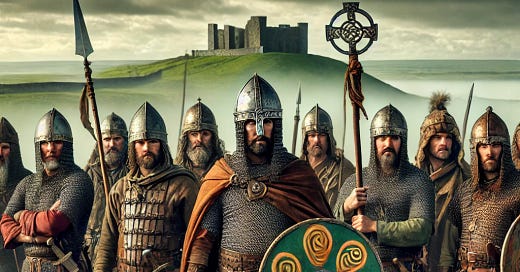How True Are the Legends of the Red Branch Knights?
The Red Branch Knights are among the most legendary warriors in Irish history, often compared to the knights of King Arthur or the Spartans of ancient Greece. Tales of their bravery, loyalty, and prowess in battle have been immortalized in Irish mythology, particularly in the Ulster Cycle, one of the four great cycles of Irish mythology. But how much of their story is true? Were they real warriors, or are they merely mythical figures woven into Ireland’s rich folklore?
To answer these questions, we must separate history from legend and explore what ancient texts, archaeology, and modern scholarship say about the Red Branch Knights.
Who Were the Red Branch Knights?
The Red Branch Knights (in Irish, Craobh Ruadh) were said to be an elite warrior band serving under King Conchobar mac Nessa, the ruler of Ulster in the first century BCE. Their name is often linked to the royal palace at Emain Macha (modern-day Navan Fort in County Armagh), where they supposedly trained and lived.
According to myth, they were not just soldiers but a brotherhood bound by honor and a strict code of chivalry, similar to the samurai of Japan. Their ranks included legendary figures such as:
Cú Chulainn – The most famous of all, often called "Ireland’s Hercules," a demigod-like warrior whose battles and superhuman feats are central to the Ulster Cycle.
Fergus mac Róich – A great warrior and former king of Ulster, who later sided with Queen Medb of Connacht.
Conall Cernach – A mighty warrior, often seen as second only to Cú Chulainn.
Lóegaire Búadach – A fierce fighter mentioned in various tales.
But were they real?
The Historical Evidence
The biggest challenge in verifying the existence of the Red Branch Knights is the lack of direct historical records. Irish mythology was primarily oral until medieval monks began recording it in texts such as:
The Book of Leinster (12th century)
The Book of the Dun Cow (11th century)
The Yellow Book of Lecan (14th century)
These sources, while important, were written centuries after the events they describe, meaning they contain embellishments and mythological elements.
However, some evidence suggests that a warrior elite in Ulster may have existed:
Emain Macha (Navan Fort)
Archaeological excavations at Navan Fort (believed to be the seat of King Conchobar) have revealed that a significant settlement existed there around 100 BCE. This aligns with the timeline of the Red Branch Knights in legend. A massive wooden structure, possibly a ceremonial or military building, was burned down—possibly as part of a ritual or after a battle.Warrior Culture in Iron Age Ireland
The warrior ethos described in the Ulster Cycle fits with what we know about Iron Age Irish society. There were warrior bands (fíanna), like those later described in the stories of Fionn Mac Cumhaill. The Celts, who inhabited Ireland at the time, had strong warrior traditions, often fighting as mercenaries in Europe.Celtic Kings and Warrior Retinues
Across the Celtic world, including Ireland, kings often surrounded themselves with elite fighters. The Red Branch Knights might have been an idealized version of such real warrior bands, exaggerated through oral storytelling.
Fact vs. Fiction: What Is Likely True?
Some aspects of the Red Branch Knights' stories likely have a basis in reality, while others are purely mythical.
Likely True:
✅ Elite warriors existed in Ulster – Kings in Celtic society had warrior bands for protection and war.
✅ Emain Macha was a powerful site – The archaeological findings at Navan Fort suggest an important center of power around the time the Red Branch Knights were said to exist.
✅ A warrior named Cú Chulainn may have existed – Many myths have historical roots, and Cú Chulainn could be based on a real warrior whose deeds were exaggerated over time.
✅ Warfare and heroism were central to Iron Age Irish culture – The emphasis on honor, bravery, and single combat in the Ulster Cycle reflects real warrior traditions.
Likely Fiction:
❌ Cú Chulainn’s superhuman feats – His battle frenzy (ríastrad), where he transforms into a monster with his body twisting inside out, is clearly mythological.
❌ Magical weapons and divine parentage – Many warriors in the legends, including Cú Chulainn, are described as demigods or possessing supernatural weapons like the Gáe Bulg (a barbed spear that explodes inside an enemy’s body).
❌ The "chivalric" code of the Red Branch Knights – While they followed a warrior ethos, it was likely far from the medieval-style chivalry later attributed to them.
❌ Prophecies and divine intervention – Many stories involve druids foretelling warriors' fates, which is common in myth but has no basis in historical evidence.
Legacy and Influence
Even if the Red Branch Knights were not a historical order as described, their legacy has had a profound impact:
Irish Literature and Mythology – The Ulster Cycle is one of Ireland’s greatest literary treasures, keeping the legend of the Red Branch Knights alive.
The Irish Nationalist Movement – In the 19th and 20th centuries, Irish revolutionaries saw figures like Cú Chulainn as symbols of resistance against British rule.
Modern Culture – The Red Branch Knights have inspired books, films, and even fantasy series like Game of Thrones, which borrowed elements from Celtic warrior traditions.
Conclusion: A Blend of Truth and Myth
The Red Branch Knights were likely based on real Iron Age warriors who fought for the kings of Ulster, but their deeds were mythologized over centuries. While they may not have wielded magical weapons or transformed into monsters, they lived in a time when bravery, combat skill, and loyalty to a chieftain were paramount.
The fusion of history and legend has kept their stories alive, making them one of the most enduring symbols of Ireland’s warrior past. Whether fact or fiction, the Red Branch Knights continue to capture the imagination, proving that legends, even if not entirely true, have a power of their own.




